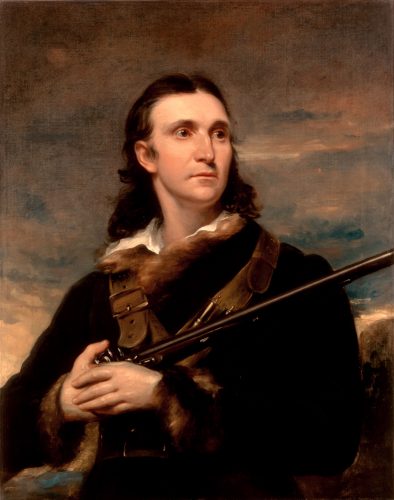
Birding — also known as “birdwatching” and, across the Pond, “twitching” — began as a lethal contact sport. When John James Audubon traveled the countryside in the early 1800s to paint the 435 watercolors that would later turn up in The Birds of America, he didn’t sit his subjects down in a studio and ask them to pose.
He shot them.
Audubon shot birds by the dozen; he blasted them by the score. According to one account he was unhappy if he shot fewer than a hundred in a day. John Syme’s 1826 oil portrait of Audubon shows the naturalist not with a bird or a paint box but with a long gun, cradled in his arms and ready to take out an egret or a crane.
This is, of course, why the birds in Audubon’s paintings and prints all look kind of dead. They were.
It wasn’t until the introduction of inexpensive optics and the development of good identification guides in the early 20th century that bird lovers were able to identify most wild birds without killing them first.
The big revolution came in 1934, when Roger Tory Peterson (why, we wonder, do all famous early birders have three names?) brought out his pocketable Guide to the Birds, widely regarded as the first true field guide. At last you didn’t have to lug an encyclopedia around to be able to sort out all the more or less identical warblers twittering in that tree.
With Peterson, no-kill birding — or “birding,” as we know it today — became possible. (“No-kill” may also apply to the large number of arguments his book settled without gunfire.)
I am not a real birder. My life list to date consists of four species of which I am certain — one of them is, I believe, a robin — and 2,197 misidentifications.
But I do know a few people who are better at birding than I am. So here, as well as I understand them, are the rules of modern birding:
No matter what time you got to bed the night before, you must get up at an ungodly hour of the morning and immediately go outside and drive a long distance in a car. In the summer, 4 am starts are typical. In the winter you’re required to wait until the roads are fully iced over. That’s all so you can hear something called the “dawn chorus,” which I would describe, but I have never been awake enough while hearing it to remember later what it sounded like.
You may think that birding occurs in pristine natural settings — just look at the gorgeous nature photos on birdish websites for, say, Swarovski Optik and the National Audubon Society. In fact, most actual birding takes place in derelict, dystopian, semi-urban places full of toxic waste. Sewage ponds are a favorite destination for waterfowl, and you haven’t lived until you’ve birded sewage ponds in rural Mexico. McDonald’s parking lots are known worldwide for gulls, who favor french fries over sardines. I know of one birder who has found two separate dead (human) bodies while chasing warblers. National parks are for tourists and the faint of heart, not for birding.
Birding is a listing activity, conceptually related to filling out a scorecard at an endless baseball game. As such it attracts many people who might politely be described as nerdy. A friend tells me you’re looked down on in parts of Texas if you show up for a bird tour without wearing the right brands of khaki pants, cargo vest and binoculars harness. In Oregon, fortunately, you need only enough Gore-Tex to go around.
Urban birding can be dangerous. You may call it “twitching”; the homeowner with two teenaged daughters may use the ugly words “peeping Tom.” Be prepared with bail money. Birds for some reason are especially drawn to obscure defense installations around the world. Be sure to memorize phrases in the local dialect for “I am not a CIA agent” and “Please call the American consulate” before birding near military bases in Latin America, the Ukraine or Arizona.
Birders are required by law to ignore chickens, to call pigeons “rock doves” and to hate starlings. I have no idea why. Also, I’m told, it’s “Canada” geese, not “Canadian” geese, unless, as birders say, they’re carrying Canadian passports. (See my record of misidentifications, above.)
Finally, you may not realize we live in a birding paradise here in Oregon. Locally, Fern Ridge Wildlife Area out on West 11th Avenue provides some of the best birding imaginable. It’s where to send nerdy visitors with binoculars to get them out of the house.
Thirty miles south of Burns, in Eastern Oregon, Malheur National Wildlife Refuge, whose headquarters just re-opened this spring after an alt-right hiatus, is one of the best birding spots in the U.S. The big blowout of the year there is coming up. On Memorial Day weekend, hundreds of people dressed in khaki vests and ergonomic binocular harnesses will drive around in dusty Subarus and argue over insignificant differences between thousands of migrating songbirds.
Me, I usually hide out in the refuge’s tiny George Benson Memorial Museum, where the beautiful bird specimens are all clearly identified with tags, having been collected in those good old days when men were men and real birders used guns.